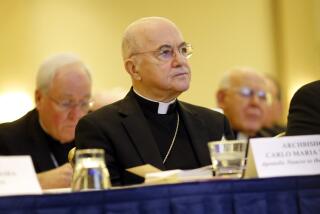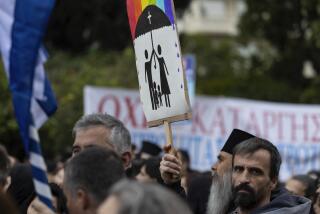Moscow and Vatican Agree to Exchange Ambassadors : Diplomacy: Full relations are foreseen. The Pope is expected to accept an invitation to visit Moscow, possibly in 1992.
- Share via
VATICAN CITY — Ending seven decades of official hostility, the Vatican and the Soviet Union agreed Thursday to exchange ambassadors for the first time since the days of the czars.
The historic decision, a fruit of Soviet President Mikhail S. Gorbachev’s meeting with Pope John Paul II at the Vatican last December, lays the cornerstone for the future establishment of full diplomatic relations.
The rebirth of formal, official ties at that ambassadorial level is a climactic milestone in long, patient Vatican diplomacy to renew the church’s presence in the Communist world.
Vatican observers read Thursday’s agreement as a signpost pointing to eventual papal acceptance of Gorbachev’s invitation to visit the Soviet Union. Vatican insiders are now talking expectantly, but unofficially, about a 1992 trip.
“This move is exceptionally important. It’s happening with the mother country of communism, the birthplace of a movement which established atheism as an official part of its policy,” said Father John Long, an American Jesuit who is a Soviet specialist at the Oriental Institute here.
Gorbachev and John Paul II agreed in their private meeting here to resume official ties between the Holy See and the Soviet Union that were broken soon after the triumph of the October Revolution in 1917. What they sought was “permanent dialogue,” and that was what they established Thursday after negotiations that prospered quickly and without a hitch.
In announcing the exchange of ambassadors, Vatican spokesman Joaquin Navarro described the re-establishment of formal ties as “pre-diplomatic relations.”
“The announcement we are making today is so new and so important that we deliberately wanted to leave a certain margin for future development,” Navarro said, saying the Holy See was “very happy to begin this way.”
Diplomats in Rome regarded the “pre-diplomatic” distinction as a nicety with more rhetorical than practical impact. The reality is that two states that reviled one another from opposite poles for so many decades will henceforth have formal, official, high-level ties.
Archbishop Francesco Colasuonno, a 65-year-old native of Puglia in the Italian south, will represent the Vatican in Moscow with the rank of apostolic nuncio. A veteran diplomat and Vatican trouble-shooter, the polyglot archbishop was the Pope’s special envoy for Eastern Europe.
Colasuonno was instrumental in the church renaissance that has accompanied sweeping political change in countries behind the collapsed Iron Curtain.
In recent months, the Vatican has resumed full diplomatic ties with Poland and Hungary. Announcement of renewed links with Czechoslovakia, where a new government has allowed the Pope to revitalize the church hierarchy, is expected before John Paul II visits there next month.
This week, the Vatican restored the leadership of the long-persecuted church in Romania, naming 12 new bishops, as many as there were when Communist persecution of religion began there in 1948.
Initially, Colasuonno and his Soviet counterpart will travel back and forth without establishing residence in the capitals where they are accredited, the Vatican said. There was no immediate announcement of the name of the Soviet representative to the Vatican, who will have full ambassadorial rank.
Colasuonno told reporters Thursday that he will quickly seek to establish contacts with Catholic communities in the Soviet Union, but he is not yet certain when he will make his first visit.
The Vatican estimates that there are about 13 million Catholics in the Soviet Union--about 8 million of the Latin rite and the rest of the Byzantine rite. Most of the Catholics are in the Ukraine, the Baltic republics of Lithuania, Latvia and Estonia and in Byelorussia. There are also small communities totaling about 1.5 million Catholics in Asian republics such as Kazakhstan and Tadzikistan, according to the Vatican, which acknowledges that its numbers are sketchy after so many years of silence.
Meeting John Paul II last year in the papal library on a cold winter’s morning, Gorbachev promised prompt passage of a law assuring greater freedom of religion in the Soviet Union.
The legislation, still pending before the Soviet Parliament, will authorize religious groups to establish internal structures--dioceses, in the case of Catholics--and to engage in social and charitable work. Catholics will also be allowed to openly maintain contacts with the Vatican and to give religious instruction, although Catholic schools would still be forbidden.
“Who could have imagined any of this in a country where Stalin executed and exiled priests and destroyed churches? In point of fact, at present we have no important problems with the Soviet government,” said a prominent member of the papal household who asked not to be identified by name.
A remaining point of friction is between the Vatican and Russian Orthodox Church, particularly in the Ukraine. Dictator Stalin proscribed the Catholic church there and ordered it absorbed into the officially approved and government-obedient Russian Orthodox Church.
Now, in the Russian religious spring, a Ukrainian community of several million so-called Uniate Catholics in communion with Rome are demanding the return of churches and buildings taken over by the Orthodox Church.
Mirroring the changes throughout Eastern Europe, Gorbachev has allowed the Vatican to reconnect fully with Catholics in the Soviet Union after decades of rupture.
In Lithuania, where four bishops and 330 priests were arrested and many of them deported to Siberia after World War II, John Paul II named a cardinal in 1988 and now has bishops in all seven dioceses.
There is a new bishop in Byelorussia, and, according to a recent Vatican report, “greater freedom for the church in Latvia and Estonia.”
More to Read
Sign up for Essential California
The most important California stories and recommendations in your inbox every morning.
You may occasionally receive promotional content from the Los Angeles Times.













